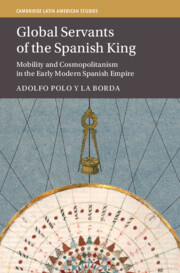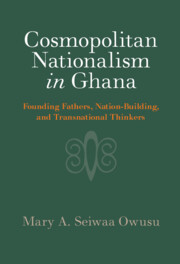Refine search
Actions for selected content:
274 results
Chapter 13 - Race
- from Part II - Themes and Issues
-
-
- Book:
- The Cambridge Companion to Modernist Theatre
- Published online:
- 28 August 2025
- Print publication:
- 11 September 2025, pp 233-249
-
- Chapter
- Export citation
7 - Fatal Wanderlust and Home Settlement
-
- Book:
- Love, Class and Empire
- Published online:
- 10 July 2025
- Print publication:
- 04 September 2025, pp 201-223
-
- Chapter
- Export citation
23 - From International Legitimacy to Global Justice
- from Part VI - Criticism and Reconstruction of the Legitimacy of International Law
-
- Book:
- The Law and Politics of International Legitimacy
- Published online:
- 14 July 2025
- Print publication:
- 24 July 2025, pp 462-487
-
- Chapter
- Export citation
Chapter 9 - Human Society and the Cosmic City
-
-
- Book:
- The Cambridge Companion to Marcus Aurelius' <i>Meditations</i>
- Published online:
- 02 July 2025
- Print publication:
- 17 July 2025, pp 172-196
-
- Chapter
- Export citation

The Cambridge Companion to Marcus Aurelius' Meditations
-
- Published online:
- 02 July 2025
- Print publication:
- 17 July 2025
11 - Bringing Cosmopolitanism Down to Earth
- from Part III - Struggling for Positive Human Development
-
- Book:
- Global Crisis and Insecurity
- Published online:
- 01 June 2025
- Print publication:
- 12 June 2025, pp 256-278
-
- Chapter
- Export citation
Classes and individuals in the European Union: Marxist and cosmopolitan approaches
-
- Journal:
- European Law Open / Volume 4 / Issue 2 / June 2025
- Published online by Cambridge University Press:
- 24 April 2025, pp. 328-347
-
- Article
-
- You have access
- Open access
- HTML
- Export citation
The History Problem: The Politics of War Commemoration in East Asia
-
- Journal:
- Asia-Pacific Journal / Volume 15 / Issue 15 / August 2017
- Published online by Cambridge University Press:
- 14 March 2025, e3
-
- Article
-
- You have access
- Open access
- Export citation
Conclusion
-
- Book:
- Global Servants of the Spanish King
- Published online:
- 20 February 2025
- Print publication:
- 27 February 2025, pp 290-296
-
- Chapter
- Export citation
Introduction
-
- Book:
- Global Servants of the Spanish King
- Published online:
- 20 February 2025
- Print publication:
- 27 February 2025, pp 1-25
-
- Chapter
- Export citation
6 - Imperial Cosmopolitanism
-
- Book:
- Global Servants of the Spanish King
- Published online:
- 20 February 2025
- Print publication:
- 27 February 2025, pp 240-289
-
- Chapter
- Export citation

Global Servants of the Spanish King
- Mobility and Cosmopolitanism in the Early Modern Spanish Empire
-
- Published online:
- 20 February 2025
- Print publication:
- 27 February 2025
1 - Introduction
-
- Book:
- The UN Convention on the Rights of the Child and Domestic Courts
- Published online:
- 09 January 2025
- Print publication:
- 23 January 2025, pp 1-19
-
- Chapter
- Export citation
Chapter 7 - Beyond the Art of Conversation
-
-
- Book:
- Nineteenth-Century Literature in Transition: The 1850s
- Published online:
- 02 January 2025
- Print publication:
- 16 January 2025, pp 158-178
-
- Chapter
- Export citation
14 - Three Responses to Shifting Borders
- from Part IV - Democratizing Shifting Borders
-
-
- Book:
- Lawless Zones, Rightless Subjects
- Published online:
- 02 January 2025
- Print publication:
- 09 January 2025, pp 247-263
-
- Chapter
-
- You have access
- Open access
- HTML
- Export citation
Chapter 2 - A Resuscitating Thing Theory
-
- Book:
- Embodied Experience in British and French Literature, 1778–1814
- Published online:
- 19 December 2024
- Print publication:
- 02 January 2025, pp 82-123
-
- Chapter
-
- You have access
- Open access
- HTML
- Export citation
Signposting the Meschita: Palermo's medieval Jewish quarter as a site of memory
-
- Journal:
- Modern Italy / Volume 30 / Issue 3 / August 2025
- Published online by Cambridge University Press:
- 27 December 2024, pp. 349-365
- Print publication:
- August 2025
-
- Article
-
- You have access
- Open access
- HTML
- Export citation

Cosmopolitan Nationalism in Ghana
- Founding Fathers, Nation-Building, and Transnational Thinkers
-
- Published online:
- 12 December 2024
- Print publication:
- 19 December 2024
Chapter 10 - The Politics of Disenchantment
-
-
- Book:
- A History of Haitian Literature
- Published online:
- 07 November 2024
- Print publication:
- 21 November 2024, pp 175-193
-
- Chapter
- Export citation
14 - Language Regimes, Global English, and National Public Education
- from Part III - Levels of Governance
-
-
- Book:
- States of Language Policy
- Published online:
- 14 November 2024
- Print publication:
- 21 November 2024, pp 267-286
-
- Chapter
- Export citation
